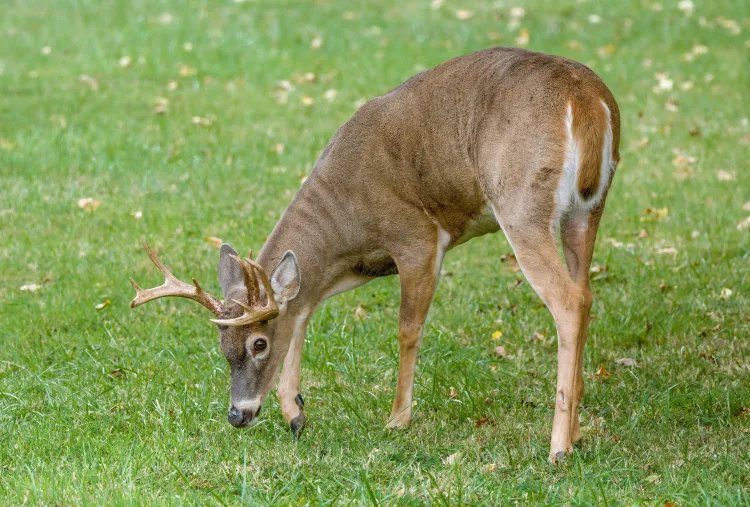
By Eunice J. Burnett
Greenwich gardeners have long felt besieged by deer. It seems these days that no plant is truly deer resistant. The devastation, however, isn’t limited to gardens. More and more scientific research is highlighting a crisis in our forests resulting from surging deer populations. The extensive overfeeding by deer, particularly white-tailed deer (Odocoileus virginianus), reduces the forest’s carbon storage capacity, destroys the understory, and hinders seedling growth. Over-browsing is causing a “regeneration debt” that will impact forest ecology for centuries. Quite simply, deer overpopulation endangers the future of our forests.
In recognition of this dynamic, The Greenwich Conservation Commission is hosting a three-part series titled, “Oh Deer! Managing Greenwich’s White-Tailed Deer Population,” in partnership with Greenwich Tree Conservancy, Greenwich Land Trust and Greenwich Audubon Center. The first session of the series will be held Wednesday, March 12, 2025, 7-8 pm in the Greenwich Town Hall Meeting Room at 101 Field Point Road and will feature Dr. Jeffrey Ward, Chief Scientist Emeritus of the Department of Environmental Science and Forestry at the Connecticut Agricultural Experiment Station and Will Kies, Executive Director at the Greenwich Land Trust, discussing the environmental impacts of deer on our community.
In pre-colonial North America, forests supported a density of four white-tailed deer per square kilometer. Deer populations were kept in check through a combination of predation by grey wolves (Canis lupus) and mountain lions (Puma concolor), subsistence hunting by Native Americans, and resource availability. By the late 1800s, the white-tailed deer was nearly driven to extinction due to overhunting and deforestation. However, changes in hunting regulations and the creation of state wildlife agencies to support the species’ recovery in the early 1900s led to a rapid rebound in deer populations. More recently, this recovery was further supported by changes in hunting regulations, the loss of top predators and habitat restoration through the regrowth of eastern forests. Currently the deer population density in Connecticut is estimated to be around 23 deer per square kilometer. Today, there is extensive, growing, and mostly undisputed scientific evidence highlighting the negative effects of high white-tailed deer populations.
“The forests of the Mid-Atlantic and Northeast are in imminent danger of collapse,” says Cornell University ecologist Bernd Blossey. “And there is little hope that business as usual or incremental changes will suffice to address the serious issues we face.” A Cornell University Department of Natural Resources’ deer population management study led by Blossey and others established that sterilization of deer and recreational hunting did not decrease the deer population as expected and determined that more aggressive initiatives were required. The unchecked growth of deer populations poses a substantial threat to the biodiversity and resilience of these forests. Important tree species like the white oak, favored by deer, struggle to mature as their seedlings are consumed before they can develop. 70 years ago, Aldo Leopold, the father of wildlife ecology, predicted that because deer disproportionately over-browse nutritive plants, species of plants with little or no nutritive value would gain a competitive advantage. As a result of such intense browsing pressure, future forests will be less diverse, and the northward migration of many tree species in response to climate change will be hindered, ultimately causing significant economic repercussions for timber industries.
The dramatic reduction in plant life compromises habitat and negatively impacts other animal populations reliant on the forest ecosystem, specifically those reliant on midstory vegetation. One Pennsylvania study concluded that areas overpopulated with deer saw a 37% reduction in bird species and a 27% decline in the diversity of species. Deer density of at least 20 animals per square mile led to the outright extirpation of five species of birds.
Peter Smallidge the director of Cornell University’s 4,200-acres Arnot Teaching and Research Forest outside of Ithaca, New York notices that important tree species such as the white oak were preferred by deer and thus these seedlings never had a chance to mature. Smallidge and his forest manager Bret Chedzov had an idea to use slash, the leftover commercially unviable trunks and treetops from logging, to create a barrier around 500 acres of forest, blocking out the deer. After six years, this section of the Arnot Forest has become the most diverse forest and healthiest ecosystem Smallidge has ever overseen. The results prove that without deer pressure, the forest can recover. Cornell ecologist Blossey believes, however, that fencing partial forests with slash isn’t enough. Instead, Blossey advocates for an integrated approach to the deer overpopulation, including systematic culling spearheaded by federal authorities responsible for wildlife, human health, transportation, and agriculture. “It was us who messed up this system,” Blossey says. “It’s our job to fix it.”
Eunice J Burnett
Advisory Board Member, Greenwich Tree Conservancy
To find out more about the Greenwich Tree Conservancy, visit us at: www.greenwichtreeconservancy.org





